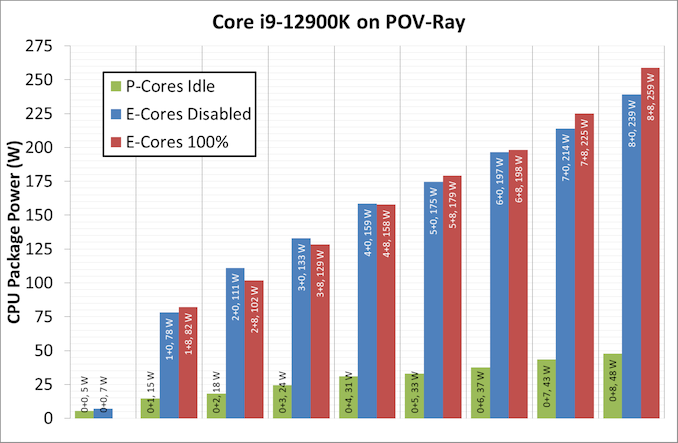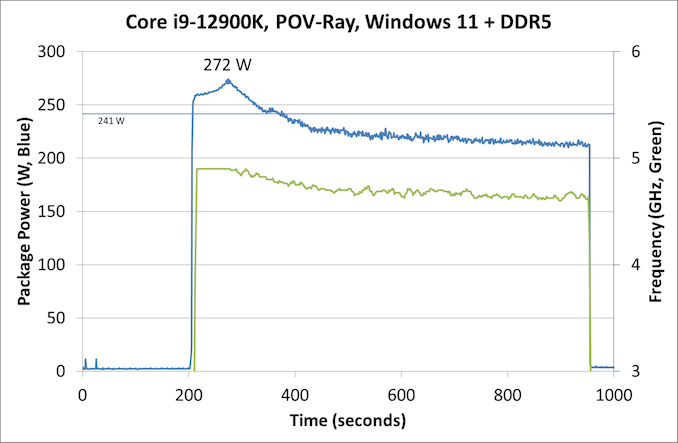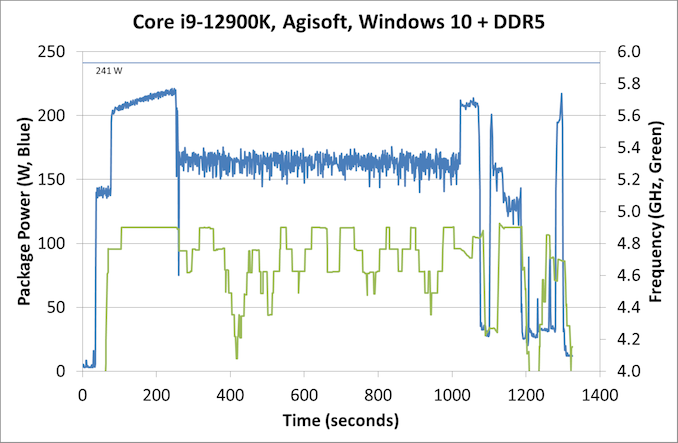The Intel 12th Gen Core i9-12900K Review: Hybrid Performance Brings Hybrid Complexity
by Dr. Ian Cutress & Andrei Frumusanu on November 4, 2021 9:00 AM ESTPower: P-Core vs E-Core, Win10 vs Win11
For Alder Lake, Intel brings two new things into the mix when we start talking about power.
First is what we’ve already talked about, the new P-core and E-core, each with different levels of performance per watt and targeted at different sorts of workloads. While the P-cores are expected to mimic previous generations of Intel processors, the E-cores should offer an interesting look into how low power operation might work on these systems and in future mobile systems.
The second element is how Intel is describing power. Rather than simply quote a ‘TDP’, or Thermal Design Power, Intel has decided (with much rejoicing) to start putting two numbers next to each processor, one for the base processor power and one for maximum turbo processor power, which we’ll call Base and Turbo. The idea is that the Base power mimics the TDP value we had before – it’s the power at which the all-core base frequency is guaranteed to. The Turbo power indicates the highest power level that should be observed in normal power virus (usually defined as something causing 90-95% of the CPU to continually switch) situation. There is usually a weighted time factor that limits how long a processor can remain in its Turbo state for slowly reeling back, but for the K processors Intel has made that time factor effectively infinite – with the right cooling, these processors should be able to use their Turbo power all day, all week, and all year.
So with that in mind, let’s start simply looking at the individual P-cores and E-cores.
Listed in red, in this test, all 8P+8E cores fully loaded (on DDR5), we get a CPU package power of 259 W. The progression from idle to load is steady, although there is a big jump from idle to single core. When one core is loaded, we go from 7 W to 78 W, which is a big 71 W jump. Because this is package power (the output for core power had some issues), this does include firing up the ring, the L3 cache, and the DRAM controller, but even if that makes 20% of the difference, we’re still looking at ~55-60 W enabled for a single core. By comparison, for our single thread SPEC power testing on Linux, we see a more modest 25-30W per core, which we put down to POV-Ray’s instruction density.
By contrast, in green, the E-cores only jump from 5 W to 15 W when a single core is active, and that is the same number as we see on SPEC power testing. Using all the E-cores, at 3.9 GHz, brings the package power up to 48 W total.
It is worth noting that there are differences between the blue bars (P-cores only) and the red bars (all cores, with E-cores loaded all the time), and that sometimes the blue bar consumes more power than the red bar. Our blue bar tests were done with E-cores disabled in the BIOS, which means that there might be more leeway in balancing a workload across a smaller number of cores, allowing for higher power. However as everything ramps up, the advantage swings the other way it seems. It’s a bit odd to see this behavior.
Moving on to individual testing, and here’s a look at a power trace of POV-Ray in Windows 11:
Here we’re seeing a higher spike in power, up to 272 W now, with the system at 4.9 GHz all-core. Interestingly enough, we see a decrease of power through the 241 W Turbo Power limit, and it settles around 225 W, with the reported frequency actually dropping to between 4.7-4.8 GHz instead. Technically this all-core is meant to take into account some of the E-cores, so this might be a case of the workload distributing itself and finding the best performance/power point when it comes to instruction mix, cache mix, and IO requirements. However, it takes a good 3-5 minutes to get there, if that’s the case.
Intrigued by this, I looked at how some of our other tests did between different operating systems. Enter Agisoft:
Between Windows 10 and Windows 11, the traces look near identical. The actual run time was 5 seconds faster on Windows 11 out of 20 minutes, so 0.4% faster, which we would consider run-to-run variation. The peaks and spikes look barely higher in Windows 11, and the frequency trace in Windows 11 looks a little more consistent, but overall they’re practically the same.
For our usual power graphs, we get something like this, and we’ll also add in the AVX-512 numbers from that page:

Compared to Intel’s previous 11th Generation Processor, the Alder Lake Core i9 uses more power during AVX2, but is actually lower in AVX-512. The difficulty of presenting this graph in the future is based on those E-cores; they're more efficient, and as you’ll see in the results later. Even on AVX-512, Alder Lake pulls out a performance lead using 50 W fewer than 11th Gen.
When we compare it to AMD however, with that 142 W PPT limit that AMD has, Intel is often trailing at a 20-70 W deficit when we’re looking at full load efficiency. That being said, Intel is likely going to argue that in mixed workloads, such as two software programs running where something is on the E-cores, it wants to be the more efficient design.














474 Comments
View All Comments
Wrs - Friday, November 5, 2021 - link
Not sure if you know what TCO is. It includes electricity and some $ allotment for software support of the hardware. Most end users don't directly deal with the latter (how many $ is a compatibility headache?) and don't own a watt-meter to calculate the former.That said, what's wrong with reusing DDR4, adapting an AM4 cooler with an LGA 1700 bracket, and reusing the typically oversized PSU? AT shows DDR4 lagging, but most DDR4 out there is way faster than 3200 CL20. That's why other review sites say DDR4 wins most benches. No reasonable user buys a 12900k or 12600k to pair with JEDEC RAM timings!
Really the only cost differentiator is the CPU + mobo. ADL and Zen3 are on very similar process nodes. One is not markedly more efficient than the other unless the throttle is pushed very differently, or in edge cases where their architectural differences matter.
isthisavailable - Friday, November 5, 2021 - link
Wake me up when intel stop K series nonsense and their motherboards stop costing twice as much as AMD only to be useless when next gen chips arrive.mode_13h - Friday, November 5, 2021 - link
Intel always gives you 2 CPU generations on any new socket. The only exception to that we've seen was Haswell, due to their cancellation of desktop Broadwell.mode_13h - Friday, November 5, 2021 - link
And besides, they had to change the socket for PCIe 5.0 and DDR5, if not also other reasons.This wasn't like the "fake" change between Kaby Lake and Coffee Lake (IIRC, some industrial mobo maker actually produced a board that could support CPUs all the way from Skylake to Coffee Lake R).
Oxford Guy - Friday, November 5, 2021 - link
So...Are we no longer going to see all the benchmark hype over AVX-512 in consumer CPU reviews?
mode_13h - Friday, November 5, 2021 - link
I think we will. They devoted a whole page to it, and benchmarked it anyway.And Ian's 3DPM benchmark is still a black box. No one knows precisely what it measures, or that it casts AVX2 performance in a fair light. I will call for him to opensource it, for as long as he continues using it.
alpha754293 - Friday, November 5, 2021 - link
Note for the editorial team:On the page titled: "Power: P-Core vs E-Core, Win10 vs Win11" (4th page), the last graph on the page has AMD Ryzen 9 5900X twice.
The second 5900X I think is supposed to be the 5950X.
Just letting you know.
Thanks.
GeoffreyA - Friday, November 5, 2021 - link
For those proclaiming the funeral of AMD, remember, this is like a board game. Intel is now ahead. When AMD moves, they'll be ahead. Ad infinitum.As for Intel, well done. Golden Cove is solid, and I'm glad to see a return to form. I expected Alder Lake to be a disaster, but this was well executed. Glad, too, it's beating AMD. For the sake of pricing and IPC, we need the two to give each other a good hiding, alternately. Next, may Zen 3+ and 4 send Alder and Raptor back to the dinosaur age! And may Intel then thrash Zen 4 with whatever they're baking in their labs! Perhaps this is the sort of tick-tock we need.
mode_13h - Friday, November 5, 2021 - link
> Intel is now ahead.Let's see how it performs within the same power envelope as AMD. That'll tell us if they're truly ahead, or if they're still dependent on burning more Watts for their performance lead.
GeoffreyA - Saturday, November 6, 2021 - link
Oh yes. Under the true metric of performance per watt, AMD is well ahead, Alder Lake taking something to the effect of 60-95% more power to achieve 10-20% more performance than Ryzen. And under that light, one would argue it's not a success. Still, seeing all those blue bars, I give it the credit and feel it won the day.Unfortunately for Intel and fans, this is not the end of AMD. Indeed, Lisa Su and her team should celebrate: Golden Cove shows just how efficient Zen is. A CPU with 4-wide decode and 256-entry ROB, among other things, is on the heels of one with 6-wide decode and a 512-entry ROB. That ought to be troubling to Pat and the team. Really, the only way I think they can remedy this is by designing a new core from scratch or scaling Gracemont to target Zen 4 or 5.